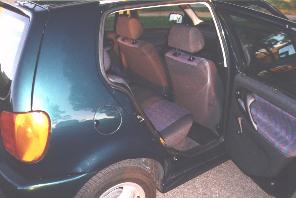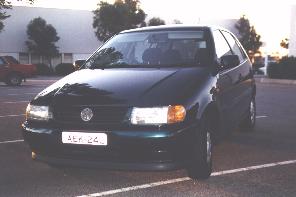
|
Volkswagen Club Road Test
Australian Volkswagen Polo
1.6 litre, 4 Door
Copyright © 1998 Bernd Felsche, Perth, Western
Australia
All Rights Reserved
This Document may not be copied without
the author's written permission.
850 km in 7 days
Bernd Felsche tests and reports on the Australianised, 1.6 litre Polo.
Test car provided by TKM.
|

|
The Test
The car was picked up from Regents on the 24th of June, and after
an initial familiarisation process, which lasted 200km or about 2 days,
the fuel tank was topped up to allow for an accurate calculation of
fuel consumption. During the familiarisation, the performance limits
were explored... which doesn't mean that I laid rubber at every set of
lights, but rather that flexibility in gear, brakes, handling and
roadholding were experienced, which is pretty much what one should be
doing when first driving a different car.
Due to initial the impression of the quality and thought that had
gone into the design and building of the car, evaluation of details was
set accordingly; which means to a high standard and corresponding
expectations. It's inevitable that as I'd only recently driven a very
similar vehicle for an extended period of 39 days, that comparisons
would, and perhaps should be drawn.
In the days following familiarisation, the road test included all
my normal driving requirements and then some more, looking for unusual
conditions against which to pitch the vehicle. Initial impressions were
refined during that period, and where possible, the factors leading to
those impressions were re-explored.
Interior
Everybody who looks at the interior is almost certainly bound to be
impressed by it's aura of solidity and quality. Once seated, the mood
is enforced by firm yet comfortable seats.
The interior trim is darker than the European model driven and
seats seem to have firmer side-bolsters providing better support during
cornering. Either the different seats, or the right-hand drive
configuration apparently conspire to reduce legroom in the back, behind
the driver. It's still adequate for average adults, but compromises
will have to be made, especially on longer trips with 4 large adults on
board.
Like its lighter-toned European sibling, the interior exudes a
feeling of quality. The lockable compartment in front of the driver is
adequate for keeping small items out of sight. Other cubby holes
provide ample opportunities to "lose" bits and pieces. Large speakers
in the door pockets look impressive and provide a reasonable level and
quality of sound, driven by the standard radio-CD player.
Looking somewhat out of place and less integrated than the European
sound systems, this particular radio-CD player was prone to rattle,
being the only fly in the ointment in that respect.
After dark, the radio's controls are not illuminated, so it takes
quite some effort to locate the tiny power switch. Once powered up, one
finds that the display, etc do not dim along with the rest of the
instruments. The German Polo driven previously provided both features,
and it remained on until the ignition key was extracted. It could then
be turned on again manually without the key. The Australian
installation turns the unit off with the ignition, and it won't switch
on at all without the ignition being on.

|
Opening either of the back doors does not cause the interior
courtesy light to come on. The reason for this is not an electrical
fault; there are no switches fitted, the holes in the body shell for
that purpose having been filled by cheap-looking plastic plugs. One can
only guess that the absence of switches is due to cost-cutting to be
able to sell the car for "less than $20,000".
The warning chime also which seems to goes off whenever you switch
the ignition on, reminding you to fasten seat belts. Also, it chimes
when either of the front doors is opened with the ignition on, or if
you happen to leave the lights on after switching the engine off. All
well-intentioned and useful. But it instills a false sense of trust: it
doesn't operate when either of the rear doors, or the hatchback is ajar
- or improperly latched.
The central locking operates on all four doors and the hatch; but
not the electric front windows. The latter could only be persuaded to
move up and down with the ignition on. Volkswagen has the know-how to
close the windows when the car is locked, bu not applied it in this
case.
|
A high-level brake light is a requirement in Australia, and the
importers have specified a slim-line one mounted to the interior of the
hatchback glass. This causes some minor obstruction to middle-distance,
rear vision. A better, though more expensive means of satisfying
regulations would probably have been to provide a roof spoiler with
integral brake light as is readily available in Europe.
The optional factory-fit air conditioning easily coped with the 25
degree "heat wave" during the week of testing. It's a worthwhile
investment for Australian conditions, given the alternative of
sweltering at those temperatures in a non-airconditioned car.
Exterior
|
Optional, light alloy wheel fitted to the test car did not enhance
the styling, looking out-of-place and, being the same 13" size as steel
wheels, did not seem to provide any benefits in vehicle dynamics. Much
more flattering (14") wheels are optional for the Polo in Germany, with
the additional benefit of improved steering response, lower rolling
resistance, and the potential for better roadholding.
Another mis-feature on the 5-door Polo relates to the occasional
requirement to refuel: The all-plastic filler flap is immediately
behind the back door on the driver's side. The cap is usually unscrewed
and hooked over the flap, (as per the owner's manual) with the cap
suspended towards the front of the car. Unfortunately, if the back seat
occupant then decides to get out of the car, the cap will be propelled
off the flap by the door. This is not only annoying; if the cap lands
in some dirt and is then replaced in the filler neck, dirt can
eventually be flushed into the fuel tank -- as if the filter didn't
have enough to do!
The simple way of avoiding potential disaster is to hook the cap
over the flap the other way around, i.e. with it suspended over the
tank opening. It's then only a very minor inconvenience when filling
the tank.
|

|
On the Road.
No matter what your driving style, the Polo exhibits exemplary
behaviour for a small car. Not surprisingly, it's reminiscent of a Mark
II Golf, being secure and confident, without the tardiness of the Mark
III Golf. It's not in the least bit skittish at speed, yet remains
responsive to driver input. Most road irregularities are met with
impunity, the vehicle running true to the intended direction. It takes
a lot to put it off line, even in a bend.
The car handling is neutral and generally tends towards mild
understeer; but there's a surprise in store for drivers used to a Golf
or the smaller-engined Polo: damp roads produce plow-on understeer when
cornering enthusiastically, [I think that this is called "big car
feel"] and lifting off the throttle doesn't help much to put the car
back on line. Golfs, and the smaller-engined Polos tend towards
oversteer with sudden throttle-off -- the degree of understeer
depending on vehicle model.
There is some initial roll when cornering, though this is not in
the least disconcerting to the occupants. Ride is supple but not
wallowy. Being a small car, it is however not impervious to being upset
by road conditions. One section of road, when tackled at a particular
speed, brought about unpleasant, jarring body movements, though it
never felt like the car was out of control. One doubts if there are
other small cars which would handle that situation even nearly as
well.
If the Golf feels like it's been milled out of solid billet, then
the Polo has been cast out of solid steel. There is no unpleasant
flexing of the body over bumps or when cornering. It feels solid. It
reinforces your decision to drive a Volkswagen, because this sort of
quality has to be engineered into the basic design of the car; it can't
be slapped on like some optional extra.
Controls are light and responsive, at the same time providing
excellent feedback. The gear change was the only notable exception. It
varies from rubbery to notchy, depending on the gear being selected,
and the direction of movement. A lack of positive feel when a gear is
engaged, can result in 3rd gear being engaged instead of first ... the
engine and clutch are sufficiently forgiving so that you can get away
with this on occasion. The sometimes vague shift may be due to the
newness of the car.
The Australian Polo's vacuum-assisted brakes have a typical
Volkswagen feel about them. Some pressure needs to be applied before
initial sponginess is overcome. Actual braking performance is average.
ABS brakes, which are standard equipment in Germany, provide a
positive, progressive feel, along with better performance for average
drivers. ABS is not presently an option for Australia.
Ancillary controls such as lights and heating are well organized
with the rotary switches working exactly as expected. The
airconditioning and recirculate push buttons need to be pressed in a
little more than one would like.
Engine performance is satisfying and smooth, if a little coarse
compared to the 1.4 litre. There is plenty of mid-range torque to make
up for a reluctance to rev to the redline (unless you're really
determined). Gearing is taller than for the 1.4 litre, revving to about
2600 rpm at 100 kmh, compared to 3000 rpm at the same speed. This
manifests itself in the 1.6's inability to sustain 60kmh in top gear
when confronted with moderate inclines. A frequently-notchy change down
to 4th is called for to keep the engine comfortable on many hills. The
benefit of taller gearing is supposed to be reduced fuel consumption,
but only if the highest gear can be held.
Fuel consumption proved to be quite good; 6.84l/100 km over the
last 660 km of road test, consisting of about 30% light suburban
traffic, 65% outer-suburban and freeway cruising, and the rest in heavy
traffic. Little use was made of the airconditioner.
Acceleration is brisk; gearing for economy means that the potential
to be a GTI is subdued. Manufacturer's performance claims are credible,
perhaps even conservative in the long run. As the engine was still
fairly new, with less than 10,000 km on the clock at the conclusion of
the test, there is probably still some loosening-up to be achieved,
resulting in better performance and possibly better fuel consumption.
Summary.
What there is to criticise about the Polo as tested, would probably
be deemed as insignificant in a lesser car. However; as the Polo is
acclaimed as the benchmark, it's important to recognize its problems
and foibles, perhaps in the hope that later cars will have some of the
areas addressed.
It appears that the more severe problems are as a result of
Australianising the Polo, be it in the choice and installation of the
audio system; selection of accessories, the tuning of the suspension or
the choice of engine and gearbox.
Overall, it's still a great car. It's very easy to live with, and
certainly something to which other small cars should aspire. When
somebody asked me how the Polo compares to a Hyundai, the following
came to mind:
"The Polo is a car. A Hyundai is an alternative to public
transport."
Originally Published in ViaWest, August 1997
Copyright © 1997,1998 Bernd Felsche, Perth, Western Australia
All Rights Reserved

